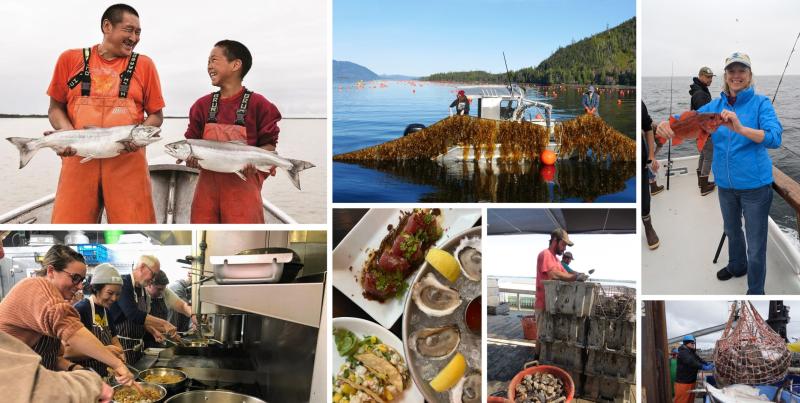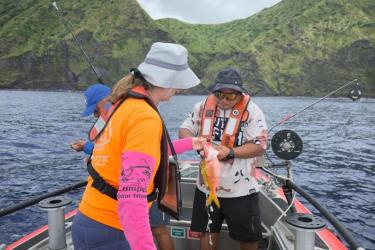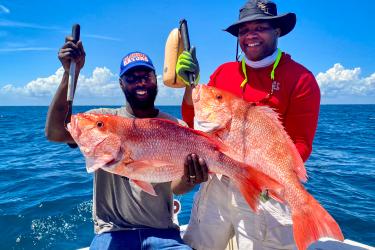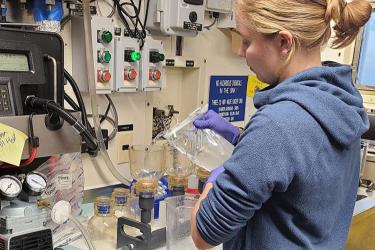Every year, we join people around the planet to celebrate World Ocean Day on June 8. In fact, at NOAA Fisheries, we celebrate the ocean all month long, designating June as National Ocean Month. As we admire its beauty and its bounty, we also recognize that our actions impact the health of our shared ocean, and that its health impacts all of us in return.
Celebrate the Ocean by Choosing Sustainably Harvested Seafood
Seafood species are not the only fish in the sea, but they are critical components of a healthy ocean. One way to show appreciation for our ocean is to be more intentional with our seafood sourcing. Fortunately, those of us in the United States needn’t look far. U.S. seafood is responsibly fished and farmed under rigorous, science-based standards aimed at maintaining our fish, shellfish, and seaweed populations into the future.
Our recently redesigned FishWatch website can help seafood consumers understand why U.S. seafood is a sustainable source of healthy protein. Now integrated with the NOAA Fisheries website, its searchable species profiles quickly connect users to the wealth of information that NOAA has on U.S. seafood species.
Watch the video below to get a tour of the new home of FishWatch.
Quickly Navigate Info on Sustainability
NOAA Fisheries sustainably manages our nation’s marine fish populations. Thanks to our science-based management, collaboration with regional councils, and sacrifices from our fishermen, more than 80 percent of our managed species are not overfished and 49 stocks have been rebuilt since 2001. Although historical fishing pressures, modern environmental conditions, complex species interactions, and a changing climate have left some stocks below optimal sizes, our responsive management process reduces fishing rates as necessary to promote population growth.
U.S. seafood is sustainable seafood, and FishWatch aims to share our best understanding of the status of U.S. seafood stocks in a transparent and accessible way. It makes it easy for consumers to get a quick snapshot on the go, or to delve into the data.
Fast Facts on the Sustainability of Wild-Caught Species
U.S. wild-caught seafood is a smart seafood choice because it is sustainably managed and responsibly harvested under U.S. regulations. That’s a reminder you’ll see when you navigate to seafood species profiles on FishWatch.
To learn more, head to the Overview tab on each profile to find a quick summary of four sustainability metrics
- Population: Many of our seafood species are managed as multiple populations, or stocks. Quickly learn whether each stock is at a healthy size or in the process of rebuilding.
- Fishing Rate: This describes the fishing pressure we understand to be taking place on each stock. Is overfishing occurring? Has the fishing rate been reduced? Is the fishery closed?
- Habitat Impacts: This describes whether fishing for this species tends to impact ocean habitats and the kinds of restrictions that are in place to mitigate damage.
- Bycatch: This describes mitigation measures to reduce the rate of accidental capture of other species in the process of fishing for the target stock.
Sustainably managing fisheries is a dynamic process. It requires continually monitoring species populations, environmental conditions, and fishing pressures. Fishery managers use this information to adapt management actions to changing conditions. If needed, they can restrict harvest levels, allowing the stock to grow while allowing fishermen to fish (and consumers to enjoy).
Fast Facts on the Sustainability of Farmed Species
U.S. farmed seafood is also a smart seafood choice because it is sustainably grown and harvested under U.S. state and federal regulations. On FishWatch profiles of farmed seafood species, you can find quick insights into:
- Environmental Impacts: What are the primary concerns, and mitigation measures, for environmental impacts of farming this species?
- Feeds: What kinds of feed are required to farm this species? How do aquaculturists tend to source the necessary proteins? Or does this species filter feed, meaning additional inputs are not required?
- Farming Methods: What does farming this species look like?
- Human Health: How are human health concerns addressed?
Dive into the Details
Beyond the basics, the species profiles contain a treasure trove of additional information for users with more questions. Where do these species live? What do they eat? How long do they live, and how quickly do they reproduce? Learn more about biology, geographic distribution, fishing methods, and management measures.
For a more detailed look at stock's status, explore the data trends by following links to the corresponding Stock Status, Management, Assessments, and Resource Trends (SMART) database entries. You’ll find graphs summarizing the catch, abundance, fishing mortality, and recruitment estimates for each species, drawn from the most recent stock assessment results.
Have Your Fish and Eat It, Too
Of course, sustainability is not the only reason to eat U.S. seafood. It’s also delicious! FishWatch contains useful tips for buying, cooking, and eating your seafood, too. This can be a helpful reference when you’re at the grocery store or the fish market considering an unfamiliar species.
Our profiles offer notes on availability, source, taste, and health benefits. You can even find descriptions of texture and filet color for finfish, and some recipes for inspiration!
Check it out to learn more about both new and familiar species!






